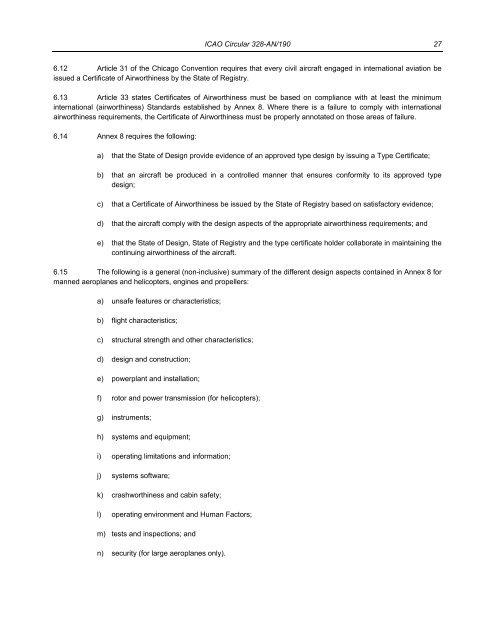1AswVkP
1AswVkP
1AswVkP
Create successful ePaper yourself
Turn your PDF publications into a flip-book with our unique Google optimized e-Paper software.
ICAO Circular 328-AN/190 27<br />
6.12 Article 31 of the Chicago Convention requires that every civil aircraft engaged in international aviation be<br />
issued a Certificate of Airworthiness by the State of Registry.<br />
6.13 Article 33 states Certificates of Airworthiness must be based on compliance with at least the minimum<br />
international (airworthiness) Standards established by Annex 8. Where there is a failure to comply with international<br />
airworthiness requirements, the Certificate of Airworthiness must be properly annotated on those areas of failure.<br />
6.14 Annex 8 requires the following:<br />
a) that the State of Design provide evidence of an approved type design by issuing a Type Certificate;<br />
b) that an aircraft be produced in a controlled manner that ensures conformity to its approved type<br />
design;<br />
c) that a Certificate of Airworthiness be issued by the State of Registry based on satisfactory evidence;<br />
d) that the aircraft comply with the design aspects of the appropriate airworthiness requirements; and<br />
e) that the State of Design, State of Registry and the type certificate holder collaborate in maintaining the<br />
continuing airworthiness of the aircraft.<br />
6.15 The following is a general (non-inclusive) summary of the different design aspects contained in Annex 8 for<br />
manned aeroplanes and helicopters, engines and propellers:<br />
a) unsafe features or characteristics;<br />
b) flight characteristics;<br />
c) structural strength and other characteristics;<br />
d) design and construction;<br />
e) powerplant and installation;<br />
f) rotor and power transmission (for helicopters);<br />
g) instruments;<br />
h) systems and equipment;<br />
i) operating limitations and information;<br />
j) systems software;<br />
k) crashworthiness and cabin safety;<br />
l) operating environment and Human Factors;<br />
m) tests and inspections; and<br />
n) security (for large aeroplanes only).


